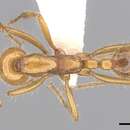pt-BR
nomes no trilho de navegação


This is the only genus of army ants found in California. These are nomadic, predacious ants that engage in group foraging. Workers are usually active at night, and often forage below the soil surface. Other ant species (both adults and brood) appear to be the principal prey items of Neivamyrmex , although the habits of the smaller, subterranean species are not well known.
Species identification: Snelling and Snelling (2005). Additional references: Borgmeier(1955), Gotwald (1995), Snelling and George (1979), Ward (1999), Watkins (1972, 1976, 1977b, 1985), Wheeler and Wheeler (1984a, 1986g).
E1 [endemic to California]
Description in preparation (Snelling& Snelling 2005).
Alto Paraguay, Amambay, Boquerón , Concepción (ALWC, INBP, MCSN).
Neivamyrmex is a genus of army ants in the subfamily Dorylinae.[2]
Neivamyrmex species can be found from the central United States to southern Argentina.[3]
As of 2021, 129 Neivamyrmex species have been identified.[3] However, most research pertaining to this genus is based on a single species, Neivamyrmex nigriscens, from which knowledge about Neivamyrmex overall is derived.[3] Many species are known based only on a small number of male individuals.[3]
Neivamyrmex do not build permanent nests; instead, colonies are nomadic, establishing temporary bivouacs every night before moving on to a new location.[4] Most species are predominantly subterranean, but they will occasionally forage above ground at night or on cloudy days.[5] The larvae and pupae of other ant species are the principle food of Neivamyrmex, including ants of the genera Veromessor, Pheidole, Solenopsis, and Formica.[6]
Male Neivamyrmex possess wings, while queens are flightless.[7] Fertilization of queens may occur purely within the colony, with mating occurring between brothers and sisters, or unrelated males may fly in from foreign colonies to reproduce.[7] After being fertilized, new queens will found new colonies by leaving their natal colonies alongside a large number of workers.[7]
Neivamyrmex es un género de hormiga guerrera de la familia Formicidae.[1]
La mayoría de las especies son subterráneas. Algunas forrajean a veces sobre la superficie durante la noche o en días nublados.[2] Se alimentan de otras hormigas o de termitas. Se conoce muy poco de su biología. La especie mejor estudiada es Neivamyrmex nigrescens.[3]
Se encuentran desde Norteamérica a Argentina.[4]
Neivamyrmex es un género de hormiga guerrera de la familia Formicidae.
La mayoría de las especies son subterráneas. Algunas forrajean a veces sobre la superficie durante la noche o en días nublados. Se alimentan de otras hormigas o de termitas. Se conoce muy poco de su biología. La especie mejor estudiada es Neivamyrmex nigrescens.
Se encuentran desde Norteamérica a Argentina.
Neivamyrmex is een geslacht van trekmieren. De wetenschappelijke naam is voor het eerst geldig gepubliceerd in 1940 door Thomas Borgmeier, oorspronkelijk als nomen novum (nieuwe naam) voor het ondergeslacht Acamatus van Eciton. Carlo Emery had Acamatus in 1894 opgericht; er bestond echter al een geslacht van snuitkevers met die naam (Acamatus Schoenherr, 1833). De naam Neivamyrmex is een eerbetoon aan de Braziliaanse wetenschapper en politicus Arthur Neiva.[1] Neiva was directeur van het Instituto Biológico van São Paulo van 1930 tot 1932, toen Borgmeier daar als entomoloog werkte. In 1950 verhoogde Borgmeier de taxonomische rang tot die van geslacht.
Deze mieren komen voor in de Nieuwe Wereld: de Verenigde Staten (vooral het zuidwesten), Mexico en Centraal-Amerika; enkele soorten zijn tot in Zuid-Amerika verspreid. Er zijn meer dan 120 soorten beschreven. Neivamyrmex nigrescens is de meest verspreide soort in de Verenigde Staten, die van het zuiden van Californië tot Florida en noordelijk tot in Nebraska en Iowa voorkomt.[2] De onderverdeling in soorten van dit geslacht is echter gecompliceerd omdat vele soorten zijn beschreven op basis van uitsluitend mannelijke dieren, terwijl andere zijn beschreven op basis van vrouwelijke dieren of werksters. Het is mogelijk dat daardoor ten onrechte aan eenzelfde soort verschillende namen zijn toegekend.[3]
Bronnen, noten en/of referentiesNeivamyrmex – rodzaj mrówek z podrodziny Ecitoninae. Obejmuje 126 opisanych gatunków.
Neivamyrmex – rodzaj mrówek z podrodziny Ecitoninae. Obejmuje 126 opisanych gatunków.
Neivamyrmex é um gênero de insetos, pertencente a família Formicidae.[1]
Neivamyrmex é um gênero de insetos, pertencente a família Formicidae.
Латинское название Neivamyrmex Borgmeier, 1940 Синонимы
Neivamyrmex (лат.) — род кочевых муравьёв из подсемейства Ecitoninae (Formicidae).
Новый Свет: Северная, Центральная и Южная Америка[1][2][3].
Мелкие и средних размеров кочевые муравьи, длина тела от около 1 см (крылатые самцы от 5 до 18 мм). Усики рабочих 12-члениковые. Нижнечелюстные щупки 2-члениковые, нижнегубные щупики состоят из 2—3 сегментов. Мандибулы треугольные. Глаза отсутствуют или редуцированы до нескольких фасеток. Оцеллии и усиковые бороздки отсутствуют. Коготки лапок простые без дополнительных зубцов на вогнутой поверхности. Проподеум округлый, без зубцов. Дыхальца заднегруди расположены в верхнебоковой её части или около средней линии проподеума. Голени средних и задних ног с одной гребенчатой шпорой. Стебелёк между грудкой и брюшком у рабочих состоит из двух члеников. Жало развито[2][1][4][5].
Ведут кочевой образ жизни. Постоянных гнёзд не имеют, кроме временных бивуаков[6][7][8]. С муравьями ассоциировано множество мирмекофилов. На теле рабочих перемещаются во время кочёвок клещи Coxequesoma, Planodiscus и Trichocylliba[9]. Муравьи переносят с собой клещей Larvamima (Larvamimidae), так как те формой своего тела напоминают личинок муравьёв.[10][11][12]
Около 130 видов[13]
Neivamyrmex (лат.) — род кочевых муравьёв из подсемейства Ecitoninae (Formicidae).